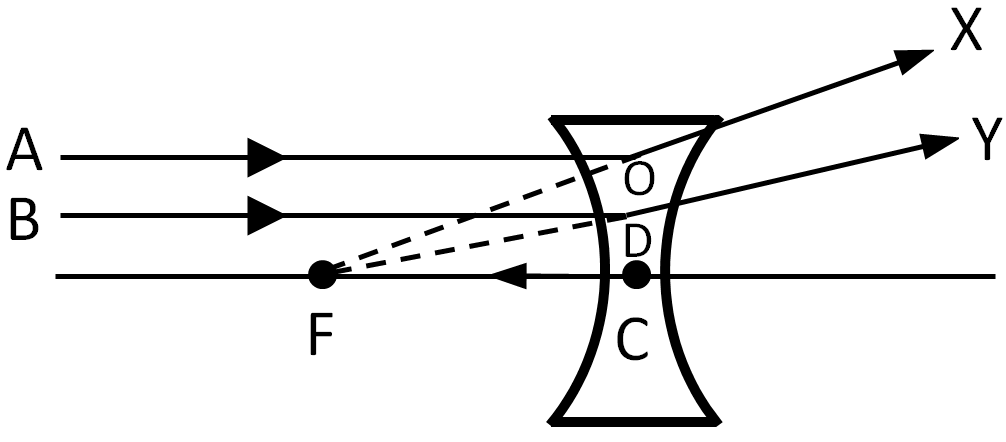As a convex lens forms different types of images depending on the position of object, similarly a concave lens also forms different types of images when the object is placed at
1. At infinity
2. Between infinity and optical centre
1. Formation of image by a concave lens when the object is placed at infinity
When an object is placed at infinity, the two rays AO and BD running parallel to the principal axis get refracted at point O and D respectively and get diverged along the directions OX and DY respectively. These diverged rays i.e. OX and DY appears to intersect each other at the principal focus of the concave lens after extending back by dotted lines. Therefore, in case of concave lens when the object is placed at infinity the image is formed at the principal focus, highly diminished (point sized), virtual and erect.

Why concave lens is called diverging lens?
A concave lens is called diverging lens because of its ability to diverge a parallel beam of light.

2. When the object is placed between infinity and optical centre
When an object AB is placed between infinity and optical centre of a concave lens, a ray of light AO which is parallel to the principal axis diverges along the direction OX after refraction and appears to come from the principal focus F along the direction OF. While the other ray of light AC goes straight through the optical centre C of the concave lens without any deviation along the direction CY. As it is clear from the figure (given below) that both the refracted rays i.e. OX and CY are diverging in nature, so these rays appear to intersect each other at point A’ on the left side of the lens on producing back. Hence, the image A’B’ formed in this case is a virtual image which is formed at the same side of the lens, between the optical centre and focus. Also the image formed is diminished and erect.

Table of Summary of Image Formed by a Concave Lens
| S No. | Position of Object | Position of Image | Size of Image | Nature of Image |
| 1. | At infinity | At the focus | Highly diminished, Point sized |
Virtual and erect |
| 2. | Between the infinity and optical centre | Between focus and optical centre | Diminished | Virtual and erect |
Differences between a Convex Lens and a Concave Lens
| S No. | Convex lens | Concave lens |
| 1. | A convex lens is thick in the middle and thin at the edges. | A concave lens is thin in the middle and thick at the edges. |
| 2. | It is converging in nature. | It is diverging in nature. |
| 3. | A convex lens has a real focus. | A concave lens has a virtual image. |
| 4. | It is used for correction of hypermetropia and presbyopia. | It is used for correction of myopia. |
Test Your Understanding and Answer These Questions:
- Explain formation of different types of images by a concave lens.
- Give differences between a concave lens and convex lens.
- Describe with the help of a ray diagram the position, size and nature of the image formed by a concave lens when the object is placed at infinity.
